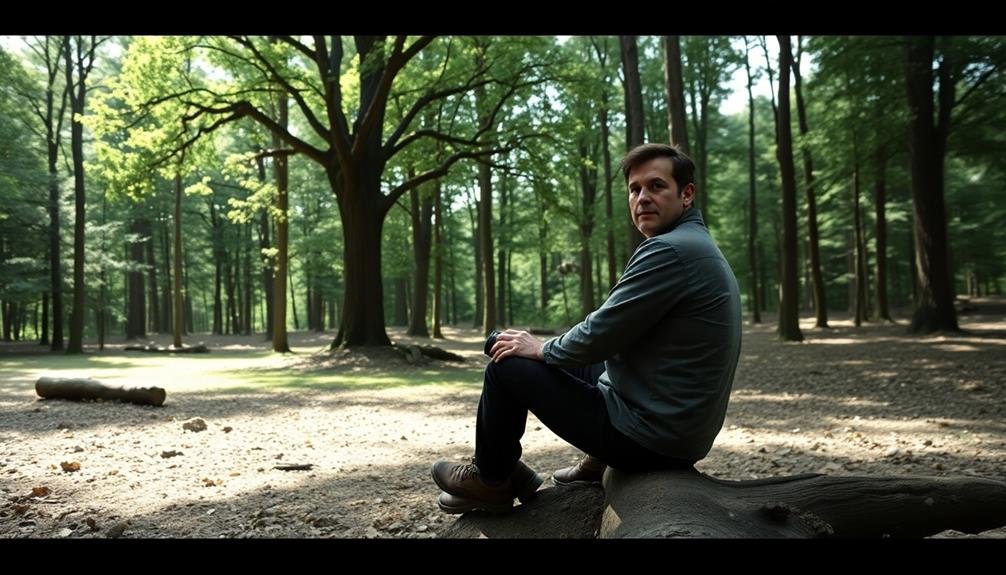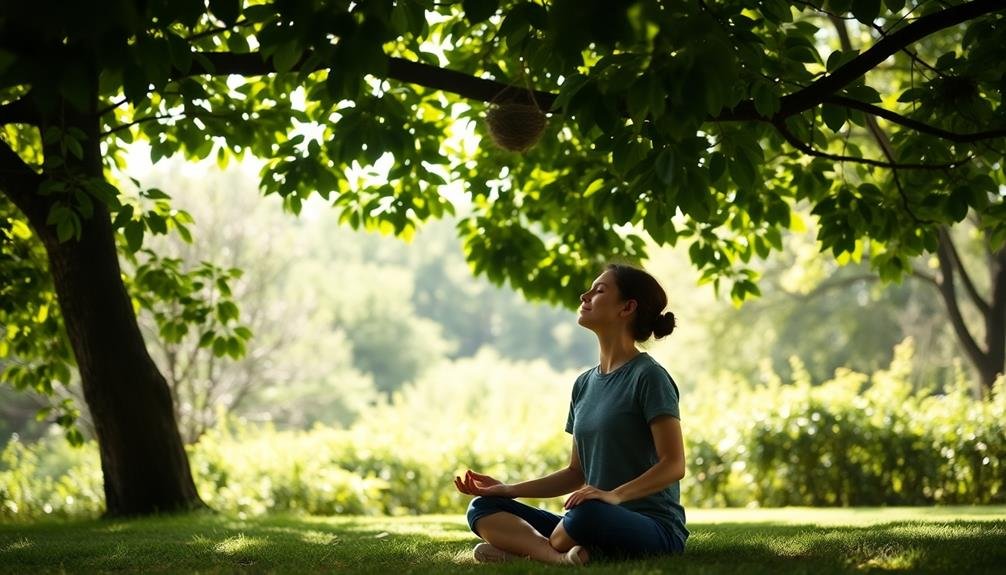To enjoy peaceful bird nest watching, start by finding a suitable location with dense foliage. Choose a comfortable spot to observe from, maintaining a respectful distance to avoid disturbing the birds. Use binoculars for close-up views without intruding. Practice mindful breathing techniques to calm your anxious mind and enhance your connection with nature. Journal your experiences to reflect on your observations and emotions. Connect with fellow bird enthusiasts to share knowledge and learn new techniques. By following these tips, you'll create a serene and mindful bird watching experience. Discover how these practices can transform your relationship with nature and provide a soothing escape from daily stresses.
Find a Suitable Nesting Location

To begin your bird nest watching adventure, you'll need to locate an ideal spot where birds are likely to build their nests. Look for areas with dense foliage, such as trees, shrubs, or tall grasses. Birds prefer sheltered locations that offer protection from predators and harsh weather conditions.
Pay attention to different habitats in your surroundings. Gardens, parks, and wooded areas are excellent places to start your search. Some birds, like robins and cardinals, often nest in suburban environments, while others prefer more secluded natural settings.
Observe bird behavior during the spring and early summer months when most species are actively nesting. Watch for birds carrying nesting materials like twigs, grass, or moss. This can lead you to potential nesting sites.
Consider installing birdhouses or nesting platforms in your yard to attract more birds. Place them at varying heights and in different orientations to appeal to various species.
Remember to maintain a respectful distance from nests to avoid disturbing the birds. Use binoculars or a spotting scope for a closer view without intruding.
Choose Comfortable Observation Spot
Once you've identified potential nesting locations, it's time to set up your observation spot. Choose a place that's far enough away to avoid disturbing the birds but close enough to see clearly.
Consider using a portable chair or cushion for comfort during long observation periods. If you're prone to anxiety, select a spot that feels safe and secure, perhaps with your back against a tree or wall.
Bring essentials like water, snacks, and sunscreen to stay comfortable for extended periods. Don't forget binoculars or a spotting scope for better visibility.
Wear neutral-colored, quiet clothing to blend in with your surroundings and minimize disturbance.
If you're observing from indoors, find a window with a clear view of the nest. Use curtains or blinds to partially conceal yourself, reducing the chances of startling the birds.
Set up a comfortable chair and keep your viewing equipment nearby.
Remember to respect the birds' space and local regulations. Never approach a nest too closely or interfere with the birds' natural behaviors.
Maintain Respectful Distance

To maintain a respectful distance while bird nest watching, you'll want to use binoculars or a camera with a zoom lens.
Position yourself behind natural barriers like bushes or trees to minimize your visibility to the birds.
Remember to keep noise and movement to a minimum, as sudden sounds or motions can startle nesting birds and disrupt their behavior.
Use Binoculars or Zoom
A key aspect of responsible bird nest watching is maintaining a respectful distance. To observe nests without disturbing the birds, you'll need to use binoculars or a camera with a powerful zoom lens. These tools allow you to get a close-up view while staying far enough away to avoid stressing the birds or alerting predators to the nest's location.
When choosing binoculars or a zoom lens, consider the following factors:
| Magnification | Field of View | Image Stability |
|---|---|---|
| 8x to 10x | Wide | Good |
| 12x to 15x | Moderate | Fair |
| 20x or higher | Narrow | Poor |
For most bird nest watching, 8x to 10x magnification is ideal. It provides a good balance between closeness and stability. Higher magnifications can make it difficult to keep the image steady, especially if you're hand-holding your equipment.
Remember to practice using your binoculars or camera before heading out. Familiarize yourself with the focus and zoom controls so you can quickly adjust them in the field. This preparation will help you make the most of your bird nest watching experience while minimizing disturbance to the wildlife.
Stay Behind Natural Barriers
In addition to using binoculars or zoom lenses, staying behind natural barriers is essential for responsible bird nest watching. Natural barriers like trees, bushes, or rocks provide excellent cover, allowing you to observe nesting birds without disturbing them. These obstacles help mask your presence and reduce the stress you might unknowingly cause to the birds.
When you find a suitable barrier, position yourself so that it's between you and the nest. This approach minimizes your visibility and scent, making the birds less likely to detect your presence. Remember, even if you can see the nest clearly, the birds may still be aware of you if you're not well-concealed.
Be patient and remain still behind your chosen barrier. Sudden movements can startle nesting birds, potentially causing them to abandon their nests. If you need to adjust your position, do so slowly and quietly.
Minimize Noise and Movement
While observing nests, it's crucial to minimize noise and movement. Your presence can stress nesting birds, potentially causing them to abandon their eggs or chicks. To avoid this, approach the nest area slowly and quietly.
Once you've found a good vantage point, remain as still as possible. Avoid sudden movements or loud noises that might startle the birds.
If you're with others, keep conversations to a whisper or use hand signals to communicate. Remember that birds have excellent hearing and can detect even soft sounds.
Turn off your phone or set it to silent mode to prevent unexpected rings or notifications. When using binoculars or cameras, move them slowly and deliberately to your eyes to avoid startling the birds with quick motions.
Maintain a respectful distance from the nest. The appropriate distance varies depending on the bird species and their tolerance for human presence.
As a general rule, if the birds show signs of distress, such as alarm calls or flying away from the nest, you're too close. Back away slowly until the birds resume their normal behavior.
Use Binoculars for Close-Up Views
Binocular-wielding bird enthusiasts can get up close and personal with nesting birds without disturbing them. When you're observing nests from a distance, binoculars are your best friend. They'll allow you to see intricate details of the nest's construction, the parent birds' behavior, and even the tiny beaks of hungry chicks.
Choose binoculars with 8x or 10x magnification for ideal bird watching. These provide a good balance between magnification and field of view. Look for models with good light transmission to enhance visibility in shaded areas where nests are often located.
Before raising your binoculars, first locate the nest with your naked eye. Then, slowly bring the binoculars up to your eyes to avoid startling the birds with sudden movements. Focus carefully, adjusting for the distance between you and the nest.
If you're shaky, try leaning against a tree or using a tripod for stability. Remember to give your eyes frequent breaks to prevent strain.
Practice Mindful Breathing Techniques

As you settle in for a bird nest watching session, practicing mindful breathing techniques can enhance your experience. By focusing on your breath, you'll calm your mind and sharpen your senses, allowing you to fully immerse yourself in the natural world around you.
Start by finding a comfortable position and closing your eyes for a moment. Take a deep breath in through your nose, holding it for a few seconds before slowly exhaling through your mouth.
To incorporate mindful breathing into your bird nest watching routine:
- Begin with a "4-7-8" breath: Inhale for 4 counts, hold for 7, and exhale for 8.
- Practice "box breathing": Inhale for 4 counts, hold for 4, exhale for 4, and pause for 4.
- Try "alternating nostril breathing": Close one nostril, breathe in, switch nostrils, and breathe out.
As you continue to observe the nest, return to these breathing techniques whenever you feel your mind wandering or anxiety creeping in.
You'll find that mindful breathing not only helps you stay present but also deepens your connection with the birds and their environment. This practice can transform your bird nest watching into a truly meditative and calming experience.
Journal Your Nest Watching Experiences
Keeping a journal of your nest watching experiences can greatly enrich your bird-watching hobby. It's a powerful tool for reflection, learning, and personal growth. As you observe nests, record details like the bird species, nest location, and construction materials. Note the dates of key events such as egg-laying, hatching, and fledging.
Don't forget to document your thoughts and emotions during these observations. You'll be surprised how your entries can help reduce anxiety and increase mindfulness. Use your journal to track patterns and behaviors over time, enhancing your understanding of local bird populations.
Here's a simple template to guide your journal entries:
| Date | Species | Nest Location | Observations | Personal Reflections |
|---|---|---|---|---|
Connect With Fellow Bird Enthusiasts

You can enrich your bird nest watching experience by connecting with other enthusiasts.
Join local birding groups to meet like-minded individuals and learn from their expertise.
Share your observations on online platforms and attend bird-watching meetups to expand your knowledge and network within the birding community.
Join Local Birding Groups
For bird nest enthusiasts, joining local birding groups can be a game-changer.
These communities offer a wealth of knowledge, support, and shared experiences that can enrich your bird-watching journey. You'll find like-minded individuals who share your passion for observing nesting behaviors and can provide valuable insights into local bird species and their habitats.
To make the most of your local birding group experience:
- Attend regular meetings and field trips to learn from experienced members and discover new nesting sites in your area.
- Participate in group discussions and share your own observations to contribute to the collective knowledge of the community.
- Volunteer for nest monitoring programs or citizen science projects to actively contribute to bird conservation efforts.
Share Observations Online
The digital age has revolutionized bird nest watching. You can now share your observations online, connecting with fellow enthusiasts worldwide. Platforms like eBird, iNaturalist, and BirdTrack allow you to log sightings, upload photos, and contribute to citizen science projects. By sharing your experiences, you're not only engaging with a community of like-minded individuals but also helping researchers track bird populations and behaviors.
When sharing online, remember to:
- Respect the birds' privacy by not disclosing exact nest locations
- Use appropriate hashtags to reach a wider audience
- Engage in discussions and ask questions to learn from others
Here's a quick guide to popular bird watching platforms:
| Platform | Focus | Key Features |
|---|---|---|
| eBird | Global bird sightings | Data visualization, personal lists |
| iNaturalist | All wildlife | AI species identification |
| BirdTrack | UK and Ireland | Migration tracking |
| Birda | Social birding | Photo sharing, challenges |
| NestWatch | Nesting data | Breeding biology research |
Attend Bird-Watching Meetups
Beyond online interactions, attending bird-watching meetups offers a unique opportunity to connect with fellow enthusiasts in person. You'll find a welcoming community of like-minded individuals who share your passion for observing nests and learning about avian behavior.
These gatherings provide a platform to exchange tips, stories, and experiences with others who understand the joy of bird watching.
To make the most of bird-watching meetups:
- Come prepared with questions about nesting habits or species identification
- Bring your field guide and binoculars to share and compare equipment
- Be open to learning new techniques from experienced birders
During these meetups, you'll often have the chance to participate in guided walks or workshops focused on nest observation.
These outings can help you discover new local spots for bird watching and improve your skills in spotting well-hidden nests. You'll also gain insights into ethical nest-watching practices, ensuring you don't disturb the birds or their habitats.
Don't be shy about sharing your own experiences and observations.
Your unique perspective might provide valuable information to the group, and you'll likely find that discussing your passion with others who share it can be both calming and invigorating.
Frequently Asked Questions
How Do I Identify Different Bird Species Nesting in My Area?
You can identify bird species nesting in your area by observing their physical characteristics, listening to their calls, and noting their behaviors. Use field guides, bird ID apps, or local birding groups to help you match your observations with specific species.
What Time of Day Is Best for Observing Nesting Birds?
You'll find early morning, just after sunrise, is the best time to observe nesting birds. They're most active then, feeding and caring for their young. Late afternoon can also be good as they prepare for nightfall.
Are There Specific Clothing Colors to Avoid When Nest Watching?
When nest watching, you'll want to avoid bright colors or patterns. Stick to muted earth tones like browns, greens, and grays. They'll help you blend in with your surroundings, making birds less likely to notice you.
How Long Does the Typical Nesting Cycle Last for Common Bird Species?
You'll find that common bird species' nesting cycles typically last 2-6 weeks. It varies by species, but generally includes nest building, egg-laying, incubation, and nestling care. You'll see different stages throughout this period.
What Should I Do if I Find an Abandoned or Fallen Nest?
If you find an abandoned or fallen nest, don't interfere. It's best to leave it alone. If there are eggs or chicks, contact a wildlife rehabilitator for guidance. Never attempt to care for them yourself.
In Summary
You've learned valuable tips for peaceful bird nest watching. Now it's time to put them into practice. Remember to be patient and respectful as you observe nature's wonders. By finding the right spot, using proper equipment, and staying mindful, you'll create a calming experience. Don't forget to document your observations and share them with others. Embrace this soothing hobby, and you'll find it's a wonderful way to ease anxiety and connect with the natural world.





Leave a Reply